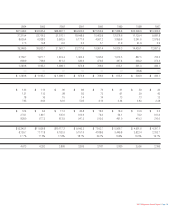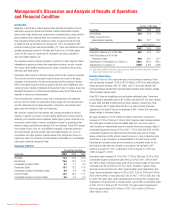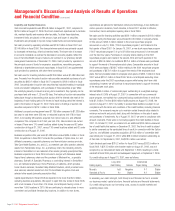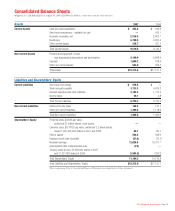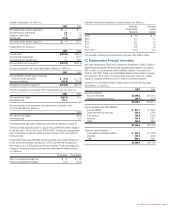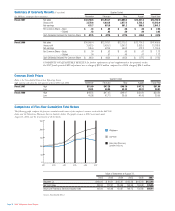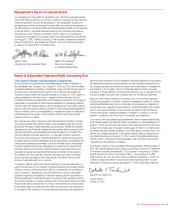Walgreens 2007 Annual Report Download - page 30
Download and view the complete annual report
Please find page 30 of the 2007 Walgreens annual report below. You can navigate through the pages in the report by either clicking on the pages listed below, or by using the keyword search tool below to find specific information within the annual report.
Notes to Consolidated Financial Statements (continued)
Advertising Costs
Advertising costs, which are reduced by the portion funded by vendors, are
expensed as incurred. Net advertising expenses, which are included in selling,
occupancy and administration expense, were $355.9 million in 2007, $306.9 million
in 2006 and $260.3 million in 2005. Included in net advertising expenses were
vendor advertising allowances of $169.8 million in 2007, $174.8 million in 2006
and $180.2 million in 2005.
Stock-Based Compensation Plans
As of September 1, 2005, the company adopted SFAS No. 123(R), “Share-Based
Payment,” using the modified prospective transition method. Under this method,
compensation expense is recognized for new grants beginning with fiscal 2006
and any unvested grants prior to the adoption of SFAS No. 123(R). The company
recognizes compensation expense on a straight-line basis over the employee’s
vesting period or to the employee’s retirement eligible date, if earlier. In accordance
with the modified prospective transition method, the financial statements for prior
periods have not been restated.
Prior to September 1, 2005, as permitted under SFAS No. 123, “Accounting for
Stock-Based Compensation,” the company applied Accounting Principles Board
(APB) Opinion No. 25 and related interpretations in accounting for its stock-based
compensation plans. Under APB Opinion No. 25, compensation expense was recog-
nized for stock option grants if the exercise price was below the fair value of the
underlying stock at the measurement date.
In November 2005, the Financial Accounting Standards Board (FASB) issued
Financial Statement of Position (FSP) No. 123(R)-3, “Transition Election Related to
Accounting for the Tax Effects of Share-Based Payment Awards.” This pronounce-
ment provides an alternative transition method of calculating the excess tax benefits
available to absorb any tax deficiencies recognized subsequent to the adoption of
SFAS No. 123(R). The company elected to adopt the alternative transition method
in the fourth quarter of fiscal 2006.
Total stock-based compensation expense for fiscal 2007 and fiscal 2006 was
$74.2 million and $102.5 million, respectively. The recognized tax benefit was
$25.7 million and $36.7 million for fiscal 2007 and fiscal 2006, respectively.
As of August 31, 2007, there was $41.0 million of total unrecognized compensation
cost related to nonvested awards. This cost is expected to be recognized over a
weighted average of 1.66 years.
Had compensation costs been determined consistent with the method of SFAS No.
123 for options granted in fiscal 2005, pro forma net earnings and net earnings
per common share would have been as illustrated in the following table
(In Millions, except per share amounts):
2005
Net earnings $1,559.5
Add: Stock-based employee compensation expenses
included in reported net income, net of related
tax effects .2
Deduct: Total stock-based employee compensation expense
determined under fair value based method for all
awards, net of related tax effects (72.5)
Pro forma net income $1,487.2
Earnings per share:
Basic – as reported $ 1.53
Basic – pro forma 1.46
Diluted – as reported 1.52
Diluted – pro forma 1.45
The company capitalizes application stage development costs for significant inter-
nally developed software projects, including “Patient Logix,” a home care operating
system; “Ad Planning,” an advertising system and “Capacity Management Logistics
Enhancements,” upgrades to merchandise ordering systems. These costs are
amortized over a five-year period. Amortization was $29.3 million in 2007, $24.2
million in 2006 and $20.4 million in 2005. Unamortized costs as of August 31,
2007 and 2006, were $143.5 million and $109.6 million, respectively.
Goodwill and Other Intangible Assets
Goodwill represents the excess of the purchase price over the fair value of assets
acquired and liabilities assumed. The company accounts for goodwill and intangibles
under Statement of Financial Accounting Standards (SFAS) No. 142, “Goodwill
and Other Intangible Assets,” which does not permit amortization, but requires the
company to test goodwill and other indefinite-lived assets for impairment annually
or whenever events or circumstances indicate there may be an impairment.
Revenue Recognition
The company recognizes revenue at the time the customer takes possession of
the merchandise. Customer returns are immaterial. Sales taxes are not included
in revenue.
Gift Cards
The company sells Walgreens gift cards to our customers in our retail stores and
through our website. We do not charge administrative fees on unused gift cards
and our gift cards do not have an expiration date. We recognize income from gift
cards when (1) the gift card is redeemed by the customer; or (2) the likelihood of
the gift card being redeemed by the customer is remote (“gift card breakage”) and
we determine that we do not have a legal obligation to remit the value of unredeemed
gift cards to the relevant jurisdictions. We determine our gift card breakage rate based
upon historical redemption patterns. Gift card breakage income was not significant
in fiscal 2007, 2006 or 2005.
Impaired Assets and Liabilities for Store Closings
The company tests long-lived assets for impairment whenever events or circum-
stances indicate that a certain asset may be impaired. Store locations that have
been open at least five years are reviewed for impairment indicators at least annually.
Once identified, the amount of the impairment is computed by comparing the
carrying value of the assets to the fair value, which is based on the discounted
estimated future cash flows. Impairment charges included in selling, occupancy
and administration expense were $9.6 million in 2007, $22.1 million in 2006
and $14.5 million in 2005.
The company also provides for future costs related to closed locations. The liability
is based on the present value of future rent obligations and other related costs
(net of estimated sublease rent) to the first lease option date.
Insurance
The company obtains insurance coverage for catastrophic exposures as well as
those risks required by law to be insured. It is the company’s policy to retain a
significant portion of certain losses related to workers’ compensation; property
losses, as well as business interruption relating from such losses; and compre-
hensive general, pharmacist and vehicle liability. Provisions for these losses are
not discounted and are recorded based upon the company’s estimates for claims
incurred. The provisions are estimated in part by considering historical claims
experience, demographic factors and other actuarial assumptions.
Pre-Opening Expenses
Non-capital expenditures incurred prior to the opening of a new or remodeled
store are expensed as incurred.
Page 28 2007 Walgreens Annual Report



